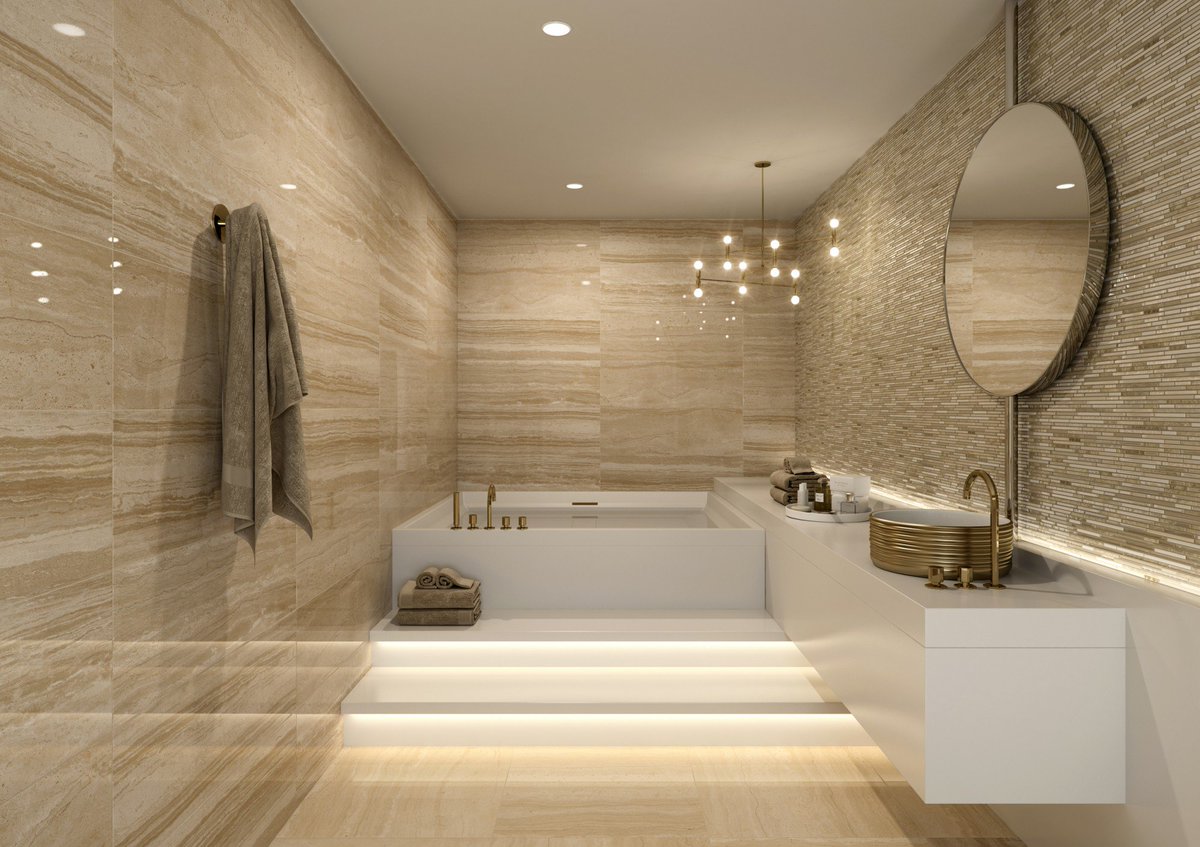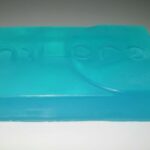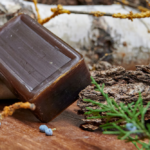Some indications to take into account for maintenance of travertine floor
- The maintenance of the travertine: it starts as soon as you lay it!
- Prevention is waterproofing
- 4 tips to waterproof your travertine
- Waterproof or vitrify?
- Porcelain stoneware with travertine effect
- Cleaning travertine: The products to use and those to avoid
- Outdoor travertine maintenance: cleaning your patio tiles
- Our travertine slabs are frost-resistant provided that they are correctly laid.
- Emergency: What to do if …
… the pores in the travertine have been badly filled or the mortar in the pores is damaged?
… my travertine has discolouration, scratches or traces of corrosion?
… I see rust stains?
… my travertine is affected by the efflorescence?

With its cream colour palette, travertine is a discreet natural stone that blends in with many styles of decoration. Whether travertine for indoors or travertine for outdoors, this natural stone floor gives your home or garden a Mediterranean charm. The roughness of the travertine is more or less numerous, depending on the model chosen. That’s why your floor can look either rustic or modern.
The maintenance of travertine – and natural stone in general – is not difficult, contrary to what one might think. Sweep, vacuum or wipe the stone with a damp cloth: that’s all you have to do to clean the travertine. Just use the right products. An unsuitable product can damage your natural stone floor in the long term. To ensure that your travertine tiles and slabs keep their original beauty forever, we have put together practical tips for cleaning and maintaining travertine.
The maintenance of the travertine: it starts as soon as you lay it!
The maintenance of the tiles begins with the laying of the travertine. To avoid making the first maintenance mistake, it is not recommended to apply a cement remover. This product is well suited to specific natural stones such as granite, but for travertine, it is too aggressive. This is why it is advisable to use a multi-cleaner. It removes stains of all kinds that would have remained since installation because of the joints. Your travertine will be perfectly maintained. Besides, you can use multi-cleaner for daily maintenance. Just dilute a drop of the product in water and your travertine floor will be as good as new.
Prevention is waterproofing
There is a product to protect your travertine from stains such as red wine or oil: waterproofing it. This product is applied to the travertine after laying the natural stone floor but before grouting, so that any mortar residues can be removed even more easily with the multi-cleaner.
Waterproofing natural stone is an essential basis for the maintenance of travertine, forming an invisible protective layer that allows the stone to breathe, making maintenance effortless and preventing stains from wine or other juices from penetrating its surface! It’s the ideal protection for your travertine. Another advantage: it is generally recommended to renew the waterproofing only every four years indoors and every two to three years outdoors. Practical and straightforward maintenance is the advantage of travertine.
4 tips to waterproof your travertine
- If you apply the waterproofing product before grouting, travertine is easier to clean afterwards. Cement residues can be easily removed.
- For the stone to absorb the waterproofing product well, your tiles must be perfectly dry and clean.
- Take care not to leave any puddles of the product on the tile. Did you apply too much? Simply wipe with a lint-free cloth.
- For optimal protection, repeat the waterproofing approximately every four years for an indoor travertine and every two to three years for an outdoor travertine, depending on the nature of the stone. It is advisable to renew the waterproofing more often for sensitive rooms or those subject to intensive use, such as the bathroom or kitchen.
Waterproof or vitrify?
A waterproofing agent is wholly absorbed by the stone and is invisible, while a glazing agent forms a visible protective film on the surface of the stone and gives it a particular shine. If you purchased the travertine for its natural charm, then you will prefer waterproofing.
Porcelain stoneware with travertine effect
Porcelain stoneware is a beautiful alternative for all those who have fallen in love with travertine but live in an area where the water is very hard or who want the lowest possible maintenance. There is an increasing demand for porcelain stoneware tiles. Reproducing the look and feel of travertine in an incredibly realistic way, they are an excellent alternative to natural stone, especially in sensitive areas.
Cleaning travertine: The products to use and those to avoid
For the maintenance of your travertine, use:
- Water, mild soap
- A mild neutral or slightly alkaline cleaner
- Maintenance products suitable for natural stone
Do not clean your travertine with the following products:
- A product containing abrasive, acidic agents or containing surface-active agents (for example: vinegar cleaners, scouring products…)
- A very greasy cleaner
- A highly basic maintenance product
- A layer-forming product
Outdoor travertine maintenance: cleaning your patio tiles
Although travertine slabs are generally more subject to dirt outdoors, their maintenance is no more difficult than indoors. Simply sweep the tiles or clean them with a garden hose. Dirt caused by the weather or your gardening work should be cleaned regularly. It is also common to clean your terrace thoroughly after the winter. Many then use a pressure washer. The latter entirely eliminates traces caused by winter weathering, but can seriously damage travertine and natural stone in general. High water pressure attacks the structure of the stone, which weakens it and then facilitates the accumulation of dirt.
If you want to take proper care of your natural stone patio, leave out high-pressure cleaners and choose softer brooms and brushes to clean the travertine.
Our travertine slabs are frost-resistant provided that they are correctly laid.
Wondering if the natural cavities in travertine reduce its frost resistance? On the contrary, the pores allow optimal water flow. Our travertine slabs, like all our other natural stone slabs, are subjected to frost resistance tests. However, the installation must be carried out correctly: it is imperative to respect a slope of at least 3% to allow water to drain. You won’t have to worry when the rain starts to fall.
Emergency: What to do if …
… the pores in the travertine have been badly filled, or the mortar in the pores is damaged?
Some holes may not have been correctly filled at the factory, or the joints may have deteriorated over time. Don’t panic, you can fix it yourself. With a mortar-joint or putty adapted to your natural stone, it is easy to fill in the pores that are bothering you.
… my travertine has discolouration, scratches or traces of corrosion?
It’s rare, but when it happens, you should treat your travertine like marble. Like marble, travertine is limestone; you can treat it as such: by sanding and polishing it. Slight signs of wear can be softened with a polishing agent, for example. To be sure that this task is carried out correctly, do not hesitate to call on an expert. However, you should be aware that there are many suitable cleaning products and sanitation kits on the market for every problem. If you opt for this solution, test the product in a hidden place in your room!
… I see rust stains?
Outside, rust stains on travertine slabs are often caused by unsuitable laying materials (e.g. gravel containing iron minerals). In this case, there are exclusive products suitable for natural stone (for example, from the brand Lithofin). These products are generally applied undiluted on the floor which is then washed after 5 to 10 minutes maximum with a multi-cleaner.
For large areas, a specialized company can help you restore the travertine floor to its original appearance. Surface work (polishing, vitrification, waterproofing) provides additional protection and optimal maintenance of the travertine.
… my travertine is affected by the efflorescence?
These whitish deposits are usually caused by the interaction of moisture, soluble minerals and external factors (e.g. animal excrement or unsuitable laying material). In most cases, it is sufficient to reduce humidity or replace defective installation material.
Note : All the advice in this article is given for information purposes only and in no way replaces the advice of a professional. en aucun cas à l’avis d’un professionnel.
If you want to see more useful information about different categories, please visit our website.











